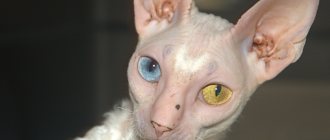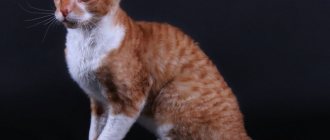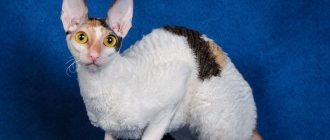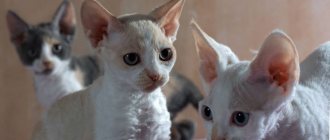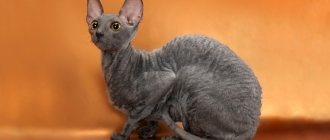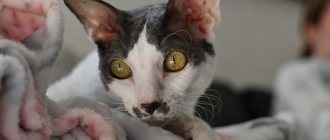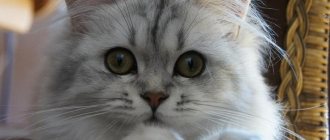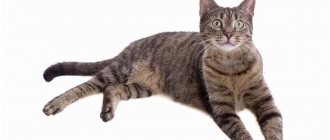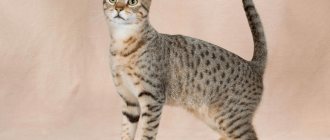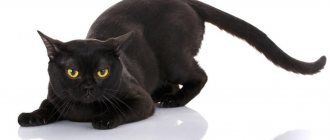Someone will say: “Ugh, what an alien!” - they will pass by and not look back, while others will be attracted by the unusual curly hair, like that of a young lamb, and... a surprisingly piercing gaze. And also the proud look and graceful gait of the queen. Yes, that's what they are - Cornish Rex cats.
No matter how they are treated, it is impossible to forget them. They are unusual and mysterious, although they owe their appearance to chance.
History of the Cornish Rex breed
The history of the unusual curly cat began in the mid-twentieth century. If you believe the official version, one kitten and Nina Ennismore, the owner of a small farm in the county of Cornwall, located on the very southwestern edge of England, are to thank for the discovery of the Cornish Rex breed. In fact, the name of the county gave the name to this breed - “Cornish” means Cornish.
The year 1950 was marked by the birth of an unusual curly-haired kitten, which was sharply different from its lambing brothers. In addition to his fur, he had a peculiar physique - a thin, graceful body, a wedge-shaped head and large ears. Similar kittens have appeared before, but their narrow-minded owners could not discern anything in them other than imagined soreness and put them to sleep. Nina could have done the same, but the kitten lived. Considering the kitten strange, the owner decided to protect the world from the spread of such “freaks” and boldly went to the veterinarian for sterilization. Once again, the kitten was lucky to meet a veterinarian who did not thoughtlessly perform the operation. He advised that you first seek advice from a genetic specialist. The expert’s explanations and arguments convinced the owner that she did not have a rejected, sickly kitten, as she had previously believed. His unusual coat is one of the manifestations of dominant genes that are important for breeding a new breed.
The kitten was named Callinbanker. Later he was brought together with his mother, an ordinary non-pedigreed cat. The resulting litter contained two kittens with curly hair. These cats have already been bred with each other. To avoid possible health problems when crossing animals that have common parents (inbreeding), a Siamese and a domestic cat were included in the breeding. Now it is impossible to breed Cornish dogs with other breeds.
7 years later, the first mentions with photographs of this amazing cat were published in the press. In 1962, the breed was given the official name – Cornish Rex.
The breed developed through two branches of selection - American and English. In 1957, two cats were exported to the states. One never gave birth, and the second was already pregnant at the time of the trip. From this moment the American type of Cornish Rex began its development.
How to choose a kitten
The box is my home
When going in search of your best friend, follow a simple rule: don’t listen to anyone but yourself! The breeder's persistent recommendations about what kind of kitten should be purchased do not always have a positive connotation. Rely only on your own intuition and do not forget that Cornish Rexes can choose their owner based on instincts.
Ideally, kittens are weaned from their mother at the age of 2.5 months. Otherwise, you risk purchasing a pet with unbalanced psychological and physical health.
It is not advisable to buy Cornish Rex at the so-called poultry markets: saving on the price of the animal will later result in huge costs for restoring the pet’s excellent health. The ideal place to purchase a kitten would be a nursery. Don’t be afraid to seem intrusive to the breeder by asking questions: usually conscientious breeders are happy to talk about their charges and, at the first request, show a veterinary passport and other important documents.
When meeting kids, pay attention to their behavior. Have you noticed the most active and cheerful one? Take it: it's yours! But lethargic kittens that do not take part in playing with their brothers should be avoided: they are probably sick and will cause you a lot of trouble in the future.
Description of the breed
At first glance, the Cornish Rex cat breed may seem puny and weak. Under the curly, velvety fur, there are well-developed muscles and a powerful skeleton. Sharp teeth and claws can easily protect a cat from an offender. This reminds us of their origin - after all, the limbers lived on a farm, and there they would always have to fight and hunt.
The weight also turns out to be greater than one might expect from appearance: males weigh up to 5 kg, and females reach 3 kg in adulthood.
Cornish Rex cats are a short-haired breed of medium to small size. The main distinguishing feature is the curly fur, reminiscent of an astrakhan fur coat. The softness is due to the absence of guard hair and dense undercoat that covers the entire body of the cat.
The absence of guard hair does not mean that the Cornish Rex is not allergic. The fact of an allergic reaction is not associated with fur at all, but with antibodies that are contained in the cat’s saliva and remain on its body after licking.
The selection of cats on different continents has manifested itself in appearance: the English type of Cornish Rex looks more knocked down, while the American type has more refined shapes. Another noticeable difference is the shape of the head. American cats have an elongated, egg-shaped shape, while English cats have a wedge-shaped shape.
Breed standard
Cornish Rex cats have the following standard appearance:
- The muzzle is ovoid or wedge-shaped depending on the type. The cheekbones stand out clearly. The forehead is rounded and smoothly merges into the Roman nose. The chin is expressive.
- The ears are cone-shaped with a wide base and rounded tips.
- The eyes are large, oval in shape, slanted and set wide apart. The iris is pigmented brightly and in accordance with the color of the coat.
- Cornish Rexes have powerful jaws with a level bite. The canines are located symmetrically relative to each other, the upper ones are slightly recessed.
- The neck is long, thin, but with well-developed muscles.
- The body is strong and flexible. The body is oblong and graceful. The stomach is taut. From some angles you can see the waist. The chest is strong, medium wide.
- The tail is whip-shaped, long.
- The legs are thin and long, with strong muscles. Strong hind legs allow them to jump to considerable heights. The toes are long and developed, the pads are oval in shape. The hind legs have four toes.
Differences between the Cornish Rex and the Devon Rex
There is a similar curly-haired cat breed that also comes from England - the Devon Rex. The main difference between the Devon Rex and the Cornish Rex is hidden in genetics: in the former, the recessive gene predominates, and in the latter, the dominant gene.
What distinguishes a Devon Rex from a Cornish Rex in appearance is its muzzle, ears and butt size. The Cornish has an egg-shaped or wedge-shaped muzzle with long, high ears. Devons have a more triangular, heart-shaped muzzle with large, wide ears. As for the pelvis, Devons have a wide, pear-shaped pelvis - this is clearly visible from behind in a sitting position.
Basic moments
- The Cornish Rex is considered one of the most active cat breeds, so prepare in advance to become the owner of a playful fidget.
- This rare cat breed is distinguished by a curly coat that is so soft that many compare it to astrakhan fur or velvet.
- The graceful body of the animal hides strong and well-developed muscles, which help it reach the highest and most inaccessible corners of the apartment.
- “The British” and “Americans” have minor differences in their appearance: for example, the former look more massive and larger.
- The Cornish Rex loves to take part in the life of his family and therefore often spins underfoot, “commenting” on what is happening with a joyful meow.
- It gets along well with children and does not conflict with other animals, but a feeling of jealousy is still inherent in this breed.
- Cornish Rexes do not like to spend their days alone, so try to give your pet most of your free time.
- Representatives of the breed are highly trainable due to their developed intelligence and do not create problems during the training process.
- They are unpretentious in care and therefore will not cause difficulties even for people without experience in keeping cats.
- Animals are famous for their excellent health and the almost complete absence of genetic diseases.
The Cornish Rex will certainly become the main reason for your carefree smile and frequent giggles. The cat's mobility and inexhaustible energy give it a resemblance to a perpetual motion machine, which was never invented, but in some incredible way found its reflection in the four-legged beauty. The Cornish Rex is the animal that will get to the highest box, the most inaccessible corner of your apartment, and its nimble and surprisingly strong paws will become its assistants. Do not choose this breed if you like more independent and calm cats.
Photos of colors
According to breed standards, the color of the Cornish Rex is allowed in all colors and patterns: solid colors, tabby, two-color, tortoiseshell.
Professionals know how to distinguish the breed and type of Cornish Rex from a photo.
Nutrition of the Dutch Rex
Rexes are prone to overeating and obesity, so food should be balanced and reasonably limited. When feeding your Rex natural food, you need to create a balanced menu for them. Like most cats, German rexes love meat most of all, but in addition to it, the diet should include offal, poultry, vegetables, cereals, eggs, and sometimes fish. A veterinarian who is an expert in animal nutrition will help you create the right menu. It is necessary to cook for your pet separately, without salt, spices and chemical additives such as flavor enhancers and flavorings. If your pet refuses to eat the recommended foods, then it is better to switch him to ready-made food.
Character and habits
In the case of the Cornish Rex breed, appearances really can be deceiving. The peculiar appearance of cats is more likely to repel the average person, but for the owners it will be an indicator of good and refined taste. Cornish Rex cats have exceptional personalities.
Cats have a mischievous disposition and will not spend most of the day lying in a secluded place and devote the rest of the time to sleep. No, such a life is not for them. The energy of an inquisitive explorer boils inside the Cornish Rex. Literally every centimeter of even already familiar space will be inspected and rechecked again. Everything that catches the Cornish’s eye will be perceived as a new or already familiar toy, but this will not make it lose its attractiveness. Therefore, if the owner is worried about the safety of valuable and fragile things, then he will have to take care of their inaccessibility.
Farming genes make every cat a ruthless pursuer of rats and mice. Balls and interactive toys that you can chase will be your favorite toys.
Cornish Rexes are loyal dogs. They will greet the owner as soon as he turns the key in the door. They will constantly, to the point of annoyingness, spin around under your feet and accompany their movements with purring. At the same time, cats subtly sense a person’s condition: if he desires loneliness, then the Cornish will give him the opportunity to be alone.
They get along well with children, but would prefer to spend less time in such company. The Cornish Rex cat is ready to fall in love with a person by asking for his attention rather than to be loved without his own desire.
Strangers make the Cornish Rex cat mistrustful. He won’t let anyone talk to him, keeping his distance. As soon as she realizes that there is no danger, she will allow herself to be petted.
Loneliness is the most unbearable thing for the Cornish Rex. In an empty apartment, a cat can do a lot of mischief. You can leave them with other animals, but it is worth remembering that Cornish cats can be jealous of their owner towards other cats. Rodents and birds will not be the best companions - hunting instincts can manifest themselves at any moment.
Pros and cons of the breed
The positive aspects of living under the same roof with a Cornish Rex include their affection and friendliness. An active and cheerful curly cat will not let you get bored alone, and by cuddling and purring his tender song in his owner’s ear, he will lift his spirits and lift him out of despondency. A kind of curly antidepressant. The Astrakhan cat is clean, easy to train, and has the ability to perform simple tricks. Cornish cats are easy to litter train and have no odor.
The point about the disadvantages made me think for a long time - it seems that the cat-lamb has no disadvantages. The only minor drawback may be the occasional stubbornness shown by the Cornish people. But a cat’s self-will and presence of its own opinion are a manifestation of its intelligence.
Care and maintenance
There are no special features for caring for the Cornish Rex. Here again the roots of farm cats emerge. The breed should be bathed no more than 2 times a month, as needed. As with all cats, it is important to keep the ears clean, otherwise inflammation may occur. The Cornish Rex's fur does not provide much warmth, so it is important to monitor the weather in your home. Even a small draft can affect your pet's health.
As for nutrition, experts advise not to skimp and feed Cornish Rex brands of at least premium class or balanced natural food. In addition to food, it is important to provide fresh, clean water throughout the day. Follow the general rules for feeding your cat.
At about a year old, the Cornish Rex breed reaches sexual maturity. It often happens that cats begin to walk at an earlier age, but this is fraught with consequences. Pregnancy, even for mature individuals, is not easy, and if this happens before one year, then the offspring will not have a good time and the mother will also have a hard time. Motherhood is easy for the Cornish Rex and the owner no longer needs to closely monitor the offspring. If there are no plans to engage in breeding, then it is better to sterilize the cat in time.
Breeding
Breeding of purebred Cornish and Devon Rex should be carried out by trusted breeders. These animals can give birth to offspring after 1 year. In such nurseries, as a rule, you can purchase kittens both as a pet without breeding rights, and premium and show class kittens with the possibility of further breeding. Such kittens have a higher cost.
Cornish Rex and Devon Rex can be crossed both with each other within the breed and with some other breeds, for example, the British Shorthair. But today, breeders strive to preserve the true gene pool of cats and do not allow crossing with all breeds.
In addition, Devon Rex and Cornish Rex cannot be crossed with each other, since they produce kittens with straight hair.
You can buy a real purebred Rex only in trusted nurseries. Their cost ranges from 15-30 thousand rubles per kitten without breeding rights. For this price you will receive an excellent representative of the breed in excellent health, vaccinated and trained to use a tray and scratching post.
About the Devon Rex breed, see the video below.
All rights reserved, 14+
The use of any materials without our prior written consent is prohibited.
Health and illness
The breed stands out for its good health. Hereditary diseases of the Cornish Rex have bypassed them and have not yet been discovered. As long as you have a balanced diet and vaccination, there should be no problems.
A feature of the breed's organism is its specific sensitivity to anesthesia. Cornish Rexes are more difficult to tolerate anesthesia than other cats. When visiting a veterinary clinic, be sure to remind the doctor about this nuance.
Many people are surprised how long Cornish Rex live. The average life expectancy is 15 years, although the breed is long-lived and cats often live up to 20 years.
Character of the Dutch Rex
As for the character of the Dutch Rex, one can note their playful, perky and curious disposition. These are very sociable cats, they always show interest in all family members and get along with other pets with ease. They adapt well to different living conditions; they can live both in a small space in an apartment and in the yard, where their instinct of a predator—a mouse catcher—is fully manifested. These cats are very smart and love various games and fun. One of the advantages of the Dutch Rex is their beautiful timbre of voice, they are talkative and their purring is very pleasant to listen to, especially when you stroke their curly and unusual-to-the-touch fur.
Buy a Cornish Rex kitten
If you want to take part in exhibitions with your cat, please contact catteries. And if you want to have a furry pet friend, then private breeders are also suitable. But in both cases, the Cornish Rex kitten must be purebred, healthy, vaccinated and able to eat independently.
Do not adopt a kitten under two months old. At 3-4 months, some deviations from the standard may already be noticeable and the pet is ready to move to a new home. It is important to take a kitten from the same house where its mother lives. This way you will learn more about his health. Pay attention to the animal's activity and its reaction to strangers.
Education and training
Two-faced Cornish Rex
In the cat world, Cornish Rexes are known as true intellectuals, so they are easy to train, even as playful kittens.
As soon as your baby steps foot into your home, draw a clear line between what can and cannot be done, and adhere to this requirement throughout the pet’s life. At the same time, it is categorically not recommended to strictly punish the Cornish for the slightest offense and raise your voice at him. To demonstrate dissatisfaction, it is enough to slap a newspaper on the floor not far from the animal, but under no circumstances raise your hand to it. Otherwise, in the eyes of the Cornish, you will look like a threat, and not a source of love and affection.
Armed with patience, you can easily teach a representative of this breed the basic “dog” commands: sit, lie down, meow and even give a paw. Rexes often learn to bring a ball or other toy to their owner. These cats are calm about walking on a harness and, in general, their behavior is more reminiscent of dogs.
Cornish Rex understand perfectly the purpose of the tray and scratching post, so there will be no problems with maintaining the pet’s hygiene.
Cornish Rex price
Depending on the purpose of acquisition, kittens are divided into classes. A pet or class pet will cost $100-150 (7,000-10,000 rubles). These kittens are sold for castration or sterilization. There is a separate breed class for breeding. Such Cornish Rex kittens will cost $250-300 (15,000-20,000 rubles). Carefully look at the kitten's pedigree and compliance with the standard of appearance - your future offspring depends on this. The price of kittens for show-class exhibitions is the highest and starts from $450 (from 30,000 rubles). The kitten should not have the slightest deviation from the standard. Parents' awards will be a plus.
Cost of kittens
The price of a baby from a cat-lamb depends on factors such as the health of the kitten, the absence of defects, the birth of the parents, the presence of breed characteristics and exhibition titles.
A small Sphynx Rex without documents will cost the owner 5-20 thousand rubles. Buying a Cornish Rex kitten with a pedigree will lighten your pocket by 20-65 thousand rubles.
Owner reviews
Anastasia Our Cornish quickly got used to the house, and most importantly, we didn’t have to explain for a long time where the toilet was. There are no problems with nutrition. The character is simply magical. I didn't expect such a playful cat.
Oleg chose the Cornish Rex after learning about their developed intelligence. The cat greets me like a dog every time I come home and follows me everywhere. I am convinced that the breed is smart literally every day - it understands everything you tell it.
Christina Despite what they write about the restlessness of Cornish Rex cats, our girl is quite calm and mannered. At the same time, you can always get her into the game. I like the sociable nature of the breed and its talkativeness.
Peculiarities
Cats and Rex cats have dense coats with curls or waves. Depending on the type of breed, the coat may be short or long.
Rexes have a slender, muscular body, long legs, a thin graceful tail and a small wedge-shaped head. The animals' ears are large and wide with rounded tips. The eyes are usually almond-shaped and color to match the fur coat. An interesting feature of the breed is that the mustache and eyebrows are very curly, as is the coat. Looking at such a cat, it becomes immediately clear that this is an expensive purebred pet. The cost of such an animal ranges from 10 to 120 thousand rubles, depending on the color of the coat, genetics, and class.
The Rex's coat is dense and shiny, sheds almost imperceptibly, but it also needs to be brushed periodically. A healthy pet has soft fur, curls of the correct shape, the hair is not tangled, and the body does not have bald patches.
As for character, this breed is unusually friendly and affectionate. Cats and Rex cats are very active, cheerful, do not like loneliness, and can “talk” with their owner for a long time and meaningfully.
If you decide to have such a pet, but you are often not at home, then it is better to think about having a friend for the Rex - another cat or even a small breed of dog.
Rexes are also distinguished by their special intelligent disposition and unpretentiousness. It is unusual for them to jump on the table and beg for food; they do not mark their territory or even scratch. Cornish Rexes are completely non-aggressive, but they will not tolerate aggression towards themselves, since they love affection very much. Rexes are wonderful friends for calm and well-mannered children.
Another feature is the ability to train the Rex to walk on a leash on the street or give a paw. These pets are extremely smart.
Body
Small in size, males are slightly larger than females. Light body type, the so-called hound or racing type. The torso must be long.
The back should be arched even in a standing position. The hips, shoulders and chest are all the same width.
The tail is plastic, quite long, tapering towards the tip. The weight of an adult cat does not exceed 3 kg, and Cornish Rex cats are allowed to gain up to 4.5 kg.
Interesting Facts
Since the advent of the Cornish Rex, a lot of interesting things have happened with curly-haired cats:
- The history of this breed could begin much earlier. But in the old days, kittens with curly hair were mistaken for scab patients and killed.
- The farm where Kalinbooker appeared specialized in breeding curly-haired rabbits.
- Cornish Rex cats are highly sensitive to anesthetics. Therefore, curly-haired cats tolerate anesthesia much harder and often show an unpredictable reaction to the most common medications.
